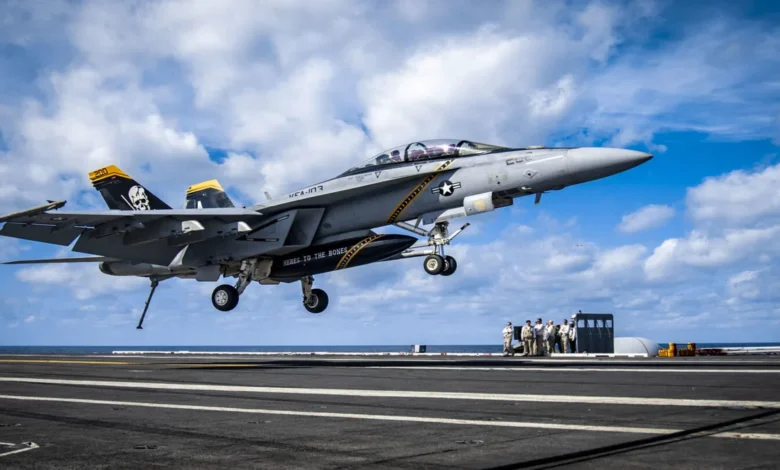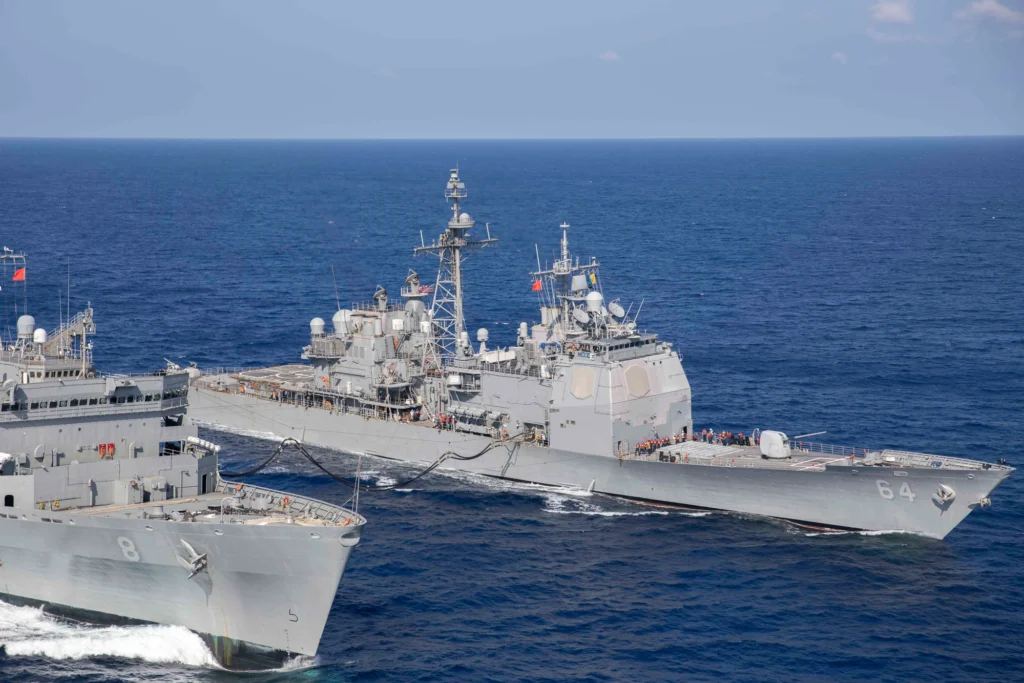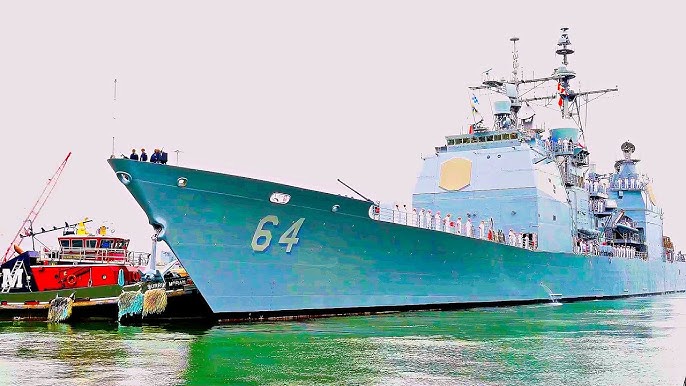The USS Gettysburg: An Icon of American Naval Power

USS Gettysburg: The USS Gettysburg (CG-64) is a Ticonderoga-class guided missile cruiser of the United States Navy, known for its distinguished service and significant role in the global presence of the U.S. military. Built to provide air defense, strike capability, and anti-submarine warfare, the USS Gettysburg is a true testament to American naval engineering and maritime strength. In this article, we will explore the from its origins and design to its operational history, service records, and its strategic importance to the Navy.
History and Development of the USS Gettysburg
The USS Gettysburg was built during a time when the United States Navy was adapting to new challenges and evolving warfare tactics. Launched in the early 1990s, this cruiser was part of the larger Ticonderoga-class program, a series of ships designed with advanced radar, missile defense systems, and versatile weaponry. The USS Gettysburg was named after the Battle of Gettysburg during the American Civil War, a pivotal event that shaped the nation’s history. This namesake was not only a tribute to the bravery and resilience displayed during the Civil War but also a reflection of the ship’s intended role as a protector of American interests on the seas.
Construction of the USS Gettysburg began at the Bath Iron Works in Maine, and the ship was officially commissioned into the United States Navy in 1991. Its design was heavily influenced by advancements in missile technology, as well as a focus on command and control systems that allowed it to function as a fleet asset in a variety of operations. With its multi-mission capabilities, the USS Gettysburg was designed to fulfill many roles, from escorting aircraft carriers to performing independent strike missions and defending the fleet against air and missile threats.
Design Features and Capabilities
One of the standout features of the USS Gettysburg is its sophisticated design, which incorporates cutting-edge technology and the latest weaponry systems. As a guided missile cruiser, the USS Gettysburg is equipped with the Aegis Combat System, a state-of-the-art radar and missile defense system that gives the ship its powerful air defense capabilities. The Aegis system enables the cruiser to track hundreds of targets simultaneously and engage threats with remarkable precision. This system is one of the most advanced of its kind, and it positions the USS Gettysburg as a key asset in U.S. naval operations.
The USS Gettysburg is also equipped with an array of missiles, including the Standard Missile-2 (SM-2) for anti-aircraft defense, Tomahawk cruise missiles for long-range strike missions, and Harpoon anti-ship missiles for surface warfare. Its versatility extends to its anti-submarine warfare capabilities, which are supported by advanced sonar systems and other technologies that allow the ship to detect and neutralize underwater threats. The ship’s hull is reinforced for stability in rough seas, while its propulsion system ensures high speed and maneuverability. The USS Gettysburg is capable of operating for extended periods without needing frequent port visits, thanks to its robust logistical support and self-sustaining capabilities.
The Role of USS Gettysburg in the U.S. Navy

Since its commissioning, the USS Gettysburg has played a pivotal role in the United States Navy, taking part in numerous missions and operations that showcase its versatility and importance. One of the most notable roles the ship has undertaken is that of a primary air defense platform for carrier strike groups. In this capacity, the USS Gettysburg protects aircraft carriers from missile and air attacks, ensuring the safety of vital naval assets. As a part of a carrier strike group, the USS Gettysburg enhances the overall offensive and defensive capabilities of the fleet, allowing for a strong and effective presence in global hotspots.
The ship’s role in missile defense is also crucial. With the proliferation of ballistic missile threats from various adversaries, the USS Gettysburg serves as a part of the broader U.S. defense umbrella against missile attacks. Its ability to launch Standard Missile interceptors makes it an important component in safeguarding both U.S. interests abroad and allied nations. This has been deployed in various regions where missile threats are prevalent, particularly in the Mediterranean and the Middle East.
Operational History and Deployments
The operational history of This is a testament to its importance to the U.S. Navy. Over the years, it has been deployed to numerous regions, participating in military operations and humanitarian missions alike. The ship’s first major deployment took place in the mid-1990s when it joined the 6th Fleet in the Mediterranean. During this deployment, This provided missile defense to U.S. assets in the region, contributing to the overall stability of the area during a period of political unrest.
In the years that followed, This participated in several critical operations, including those in the Persian Gulf, the Mediterranean Sea, and the Western Pacific. Its presence in these areas helped to deter potential threats, and the ship was involved in numerous exercises and training missions alongside NATO and allied forces. This also provided humanitarian aid in response to natural disasters, showcasing the Navy’s ability to deploy its forces for non-combat operations when needed.
Technological Innovations and Modern Upgrades
As technology continued to evolve, so too did This. The ship underwent several upgrades over the years to ensure it remained at the forefront of naval warfare. One of the most significant upgrades was the installation of the Navy’s latest radar and communication systems, which enhanced the ship’s ability to detect and respond to threats. These upgrades not only improved the ship’s operational capabilities but also ensured that it remained compatible with the broader fleet.
The USS Gettysburg also received improvements to its combat systems and weapons, ensuring that it could engage the full spectrum of threats, from ballistic missiles to air and surface targets. These upgrades have extended the ship’s operational life and ensured that it remains an integral part of the U.S. Navy’s capabilities. Even as new classes of ships were introduced, This remained a formidable asset, capable of performing a wide range of missions with impressive effectiveness.
Strategic Importance of USS Gettysburg in Global Security
The USS Gettysburg holds a significant strategic position in the U.S. Navy’s fleet, not only because of its advanced weaponry and capabilities but also due to its role in supporting U.S. military objectives worldwide. As a key asset in the Navy’s global strategy, This has been deployed to protect vital shipping lanes, deter regional conflicts, and maintain a forward U.S. presence in areas of strategic interest.
In addition to its military capabilities, This also plays a crucial diplomatic role, helping to maintain and strengthen relationships with U.S. allies around the world. Whether participating in joint exercises with NATO forces or engaging in humanitarian missions, This is a symbol of American naval strength and commitment to global security. Its presence in international waters sends a clear message of American power, resolve, and willingness to defend freedom and democracy.

Life Aboard the USS Gettysburg
Life aboard This, like on most Navy ships, is a unique experience that combines rigorous training, high-stress situations, and camaraderie. Crew members aboard This must be prepared for a variety of duties, ranging from standing watch on the bridge to conducting maintenance on complex weapon systems. The work environment aboard the ship is fast-paced and demanding, with crew members often working long hours to ensure the ship remains combat-ready.
Despite the challenges of life at sea, sailors aboard This formed tight-knit bonds that lasted long after their service. The ship’s crew is made up of sailors from all walks of life, from young recruits to seasoned veterans, and the shared experience of serving aboard a ship like This creates a strong sense of unity and pride. As with most U.S. Navy ships, there is a focus on teamwork, discipline, and mutual respect.
Decommissioning and the Future of USS Gettysburg
Like all naval vessels, This will eventually face the end of its service life. However, the legacy of the ship is one that will continue to be felt within the U.S. Navy for years to come. As newer, more advanced ships join the fleet, This may eventually be decommissioned and retired from active service. Nevertheless, its contributions to national and global security will be remembered, and the lessons learned from its operational history will continue to inform future naval strategies and ship designs.
As the U.S. Navy looks to the future, it is clear that This has played a significant role in shaping the modern naval landscape. The ship’s legacy will not be forgotten, and its place in the history of the U.S. Navy will be cemented as a symbol of strength, innovation, and dedication to service.
In conclusion, This has had a remarkable career, and its contributions to the U.S. Navy’s missions and objectives are immeasurable. As a guided missile cruiser, it demonstrated the power of advanced technology and combat systems in ensuring the protection of U.S. interests both at home and abroad. The USS Gettys burug ’ s ability to adapt to new challenges, along with its dedicated crew and unwavering mission focus, has ensured its place in naval history. Whether as a defense platform, a diplomatic tool, or a symbol of American power, This stands as a proud testament to the United States Navy’s commitment to safeguarding the nation and promoting peace on the world stage.






